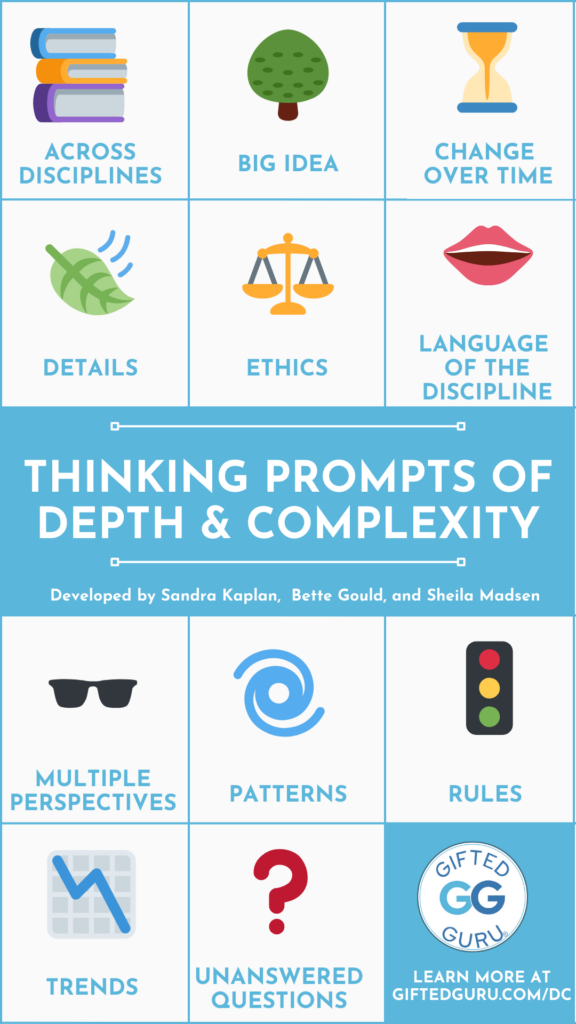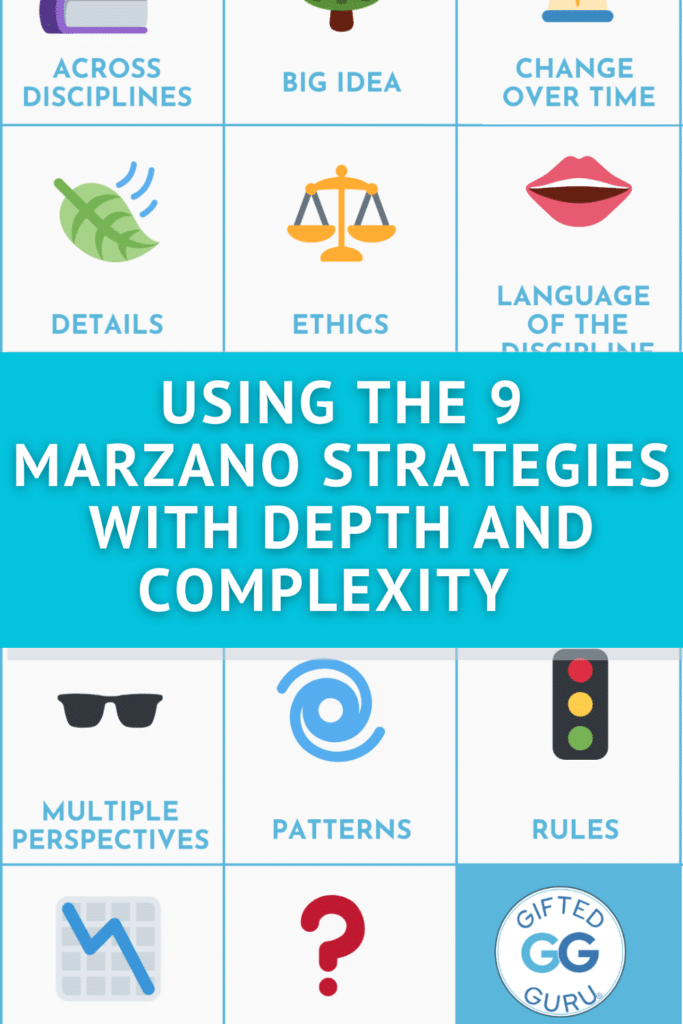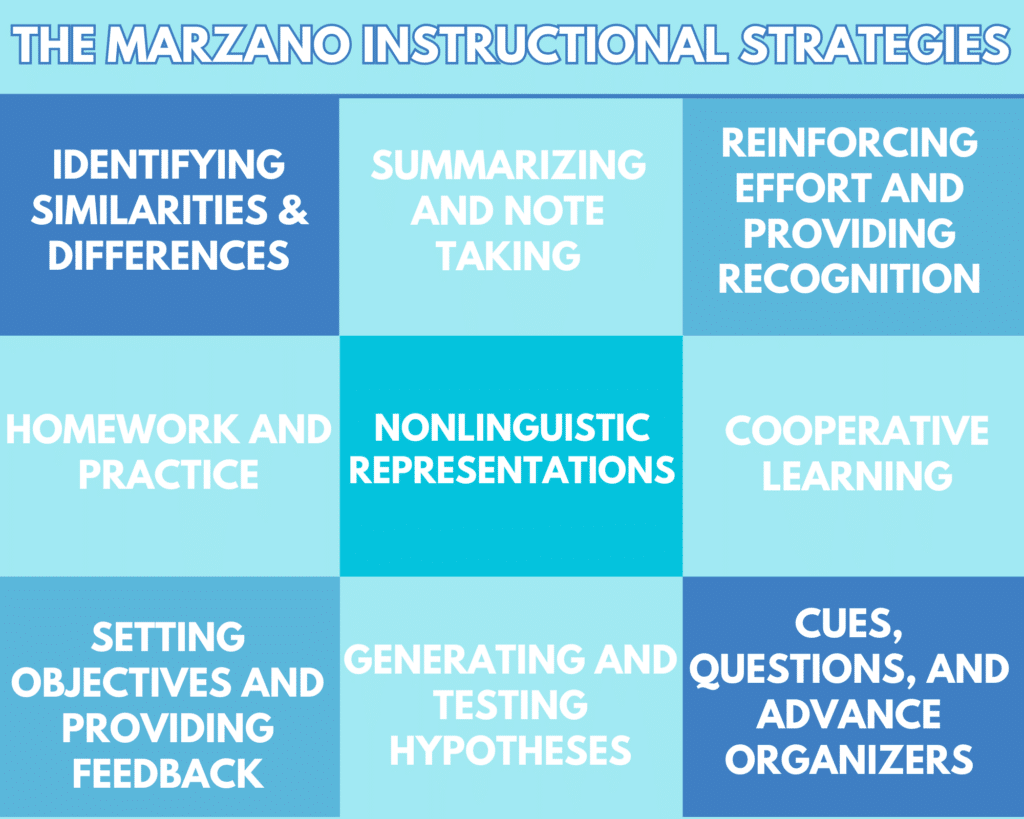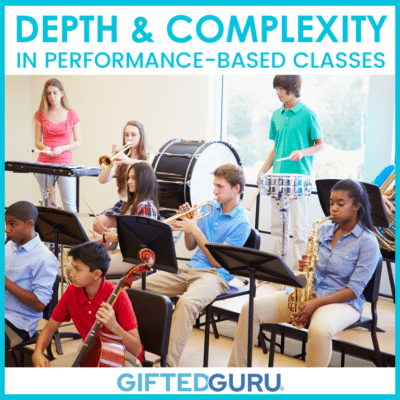Recently, a teacher emailed me if the nine Marzano instructional strategies integrate with the Depth and Complexity framework. As co-author of the book on Depth and Complexity, she assumed I would know.
The short answer is yes, they do.
Before I explain exactly how they connect and how teachers can use Depth and Complexity with Marzano, I want to clarify an importance distinction:
Marzano’s strategies are tasks, not thinking. The thinking prompts of Depth and Complexity are thinking, not tasks.
They are not competing with each other. You can use Depth and Complexity to accomplish the Marzano strategies, and you can use the Marzano strategies to reinforce the thinking done with Depth and Complexity.
Let’s briefly look at each of these researchers’ models, and then look at the connections between the two.
Marzano Instructional Strategies
The nine Marzano strategies are a set of instructional strategies curated by educational researcher Robert Marzano specifically designed to improve student achievement across a wide range of grade levels and content areas.
Two important things to know:
- Research-based: Dr. Marzano compiled research on various instructional methods and identified these nine as having the strongest positive impact on learning across different subjects and grade levels. He did not invent the strategies. Rather, he looked at a lot of strategies and culled these out as the winners.
- Effect sizes: Each strategy has a reported effect size. Effect size is a statistic indicating the strategy’s impact on student achievement. These range from 28% to 45% percentile gains, which are significant improvements. However, Marzano himself has written about the impact of teacher implementation on the effect size. They’re methods, not magic.
9 Marzano High-Yield Strategies
The nine strategies Marzano chose as the most effective are:
- Identifying Similarities and Differences: Breaking a concept into its similar and dissimilar characteristics to another concept enables students to effectively tackle complex problems and ideas. This can be teacher directed or student discovered. Graphic forms work well for this.
- Summarizing and Note Taking: This promotes greater comprehension by asking students to analyze and synthesize information in their own words. This requires evaluation, substitution, and deletion. Note taking on a computer will be less effective here because it doesn’t require those skills. This isn’t verbatim note taking. This is thinking combined with note taking.
- Reinforcing Effort and Providing Recognition: Students need to see the connection between their effort and their achievement. Teachers should recognize student effort that leads to achievement in order to help students recognize the importance of effort.
- Homework and Practice: The purpose should be clear and feedback should be given. [Note: This strategy’s effect size is shockingly different for different grade levels. For high school, it produced a 24-point gain. In middle school, it produced a 12-point gain, and in elementary school, it only produced a 6-point gain.] The purpose of the homework should be clear. Is it for practice, elaboration, or preparation?
- Nonlinguistic Representations: Using both visual and linguistic forms of knowledge aids achievement. Visuals attached to learning aids in transfer – the ability of students to apply knowledge learned in other settings – because it helps them make connections.
- Cooperative Learning: Working in groups yields an overall positive impact (not necessarily true for gifted learners in mixed-ability groups). Groups should be small, and the strategy should not be overused.
- Setting Objectives and Providing Feedback: Setting objectives provides goals for students’ learning. They shouldn’t be so specific that they’re not adaptable to different students’ needs. Feedback is essential to growth, but if done improperly, research shows it can do more harm than good.
- Generating and Testing Hypotheses: Deductive approaches where students use their understanding of general rules to make predictions about specific outcomes work best. Students have to clearly explain their hypotheses and conclusions, not simply list them.
- Cues, Questions, and Advance Organizers: Activating students’ prior knowledge about a topic enhances further learning. These activities should be highly analytical, focus on what’s important, and be used before the learning experience.
The Depth and Complexity Framework
You have probably seen the common Depth and Complexity icons (although I use emoji to represent the thinking prompts of Depth and Complexity).
There are eleven different thinking prompts. I’ve written extensively about Depth and Complexity, so I will simply list the thinking prompts here. This article goes into more depth about each thinking prompt and the icons of Depth and Complexity.

The 11 Thinking Prompts of Depth and Complexity
Here are the eleven prompts (in alphabetical order):
- Across Disciplines 📚 (How does this look in other disciplines, and how does it look in other ways in this discipline/content area?)
- Big Idea 🌳 (Summarize all that you now know after learning.)
- Change over Time ⏳ (How is this different know than it was, and what will it be in the future?)
- Details 🍃 (What are the distinguishing characteristics, how important are they, and how do they support higher-order thinking about the topic?)
- Ethics ⚖️ (How is this fair or unfair? What are the pros/cons? How does this cause or complicate problems?)
- Language of the Discipline 👄 (How do experts talk about this? Who are the people? What are the tools?)
- Multiple Perspectives 🕶️ (How do other people/objects think about this? How else can this be seen, and how does that impact thinking?)
- Patterns 🌀 (What repeats and can be predicted? How is this cycle similar to another cycle?)
- Rules 🚦 (How is this impacted by methods, directions, standards, and other rules?)
- Trends 📉 (What is the direction this is heading? Positive/Up? Negative/Down? Stasis? What are the factors acting on it? Compare and contrast.)
- Unanswered Questions ❓ (What do you not know because it cannot be known? What do you not know, but you could know it if you had access to certain resources? What do you have an informed opinion about, but someone else has a different informed opinion?)
How the Marzano Strategies Fit with Depth and Complexity
Now that you have a brief overview of the two ideas, let’s look at how they fit together.
First, it’s critical to understand these ideas that I mentioned briefly above:
- Marzano Strategies and the Depth and Complexity Framework are not two competing ideas. They are completely different pedagogical tools.
- You would use Depth and Complexity *with* the Marzano strategies, not instead of or in addition to.
- Depth and Complexity is about quality of thinking and fits with any pedagogical strategy (like those in Marzano).
Let’s look at the different Marzano strategies and see how we would integrate Depth and Complexity into them:
- Identifying Similarities and Differences: This Marzano strategy has perhaps the clearest Depth and Complexity connection. We use the Ethics ⚖️ prompt to look at pros and cons, the Details 🍃 prompt to examine traits, and the Trends 📉 prompt to compare and contrast.
Depth and Complexity augments and enriches this Marzano strategy by giving teachers specific tools to use in the analysis.
In the Classroom:
> A teacher may use the Patterns 🌀 prompt to have students classsify items to create categories based on similarities and differences.
> A Venn diagram can be used with different Depth and Complexity prompts (like those listed above) to have students compare and contrast the different aspects of a piece of content. - Summarizing and Note Taking: his is another Marzano strategy that dovetails perfectly with Depth and Complexity. When students are taking notes, they are essentially recording the Details 🍃 shared by the teacher, video, or text.
In the Classroom:
> The Big Idea 🌳 thinking prompt should be used for summary. That is essentially what summarizing is: identifying the Big Ideas 🌳 of a sentence, paragraph, or longer piece of material/text.
> Teachers can have students sketch a leaf instead of bullet points to indicate that Details 🍃 are being recorded.
> Teachers can also use Unanswered Questions ❓ to have students question what is unclear.
> Teacher-prepared notes are themselves Rules 🚦 because they are a prescripted method.
> Students can use Language of the Discipline 👄 to highlight key words in their notes. - Reinforcing Effort and Providing Recognition: This is part of the Rules 🚦 of the classroom because it is the teacher’s method for celebrating work.
In the Classroom:
> Have students track the Details 🍃 about of their efforts and regularly analyze that data using different thinking prompts to keep it interesting and varied.
> Set intervals for recognition is Patterns 🌀.
> Use the Pause, Prompt, Praise 🚦 method. To do this, if a student is struggling, pause to discuss the issue, then prompt the student with specific suggestions, then praise the student if the adjustments made lead to success. - Homework and Practice: This is Details 🍃 and Big Idea 🌳. First, what are the Details 🍃 of the homework assignment? Next, what is the Big Idea (purpose) 🌳 of it? Is it preparation, practice, or elaboration?
In the Classroom:
> Teachers can have students record the Details 🍃 and Big Idea 🌳 of the homework in their planners.
> If using an LMS like Canvas, teachers can use the emoji to indicate the specifics 🍃 of the assignment and the purpose 🌳 of it. - Nonlinguistic Representations: The icons of Depth and Complexity (or emoji) are themselves nonlinguistic representations, so this is a meta-use of Depth and Complexity.
In the Classroom:
> Have students sketch the icons or emoji in their work. - Cooperative Learning: This is one of the Marzano strategies that is completely task-dependent. What I mean by that is that the Depth and Complexity connection will depend entirely upon what the group’s task is. The assignment itself will guide the Depth and Complexity integration.
In the Classroom:
> When students are working in groups, teachers should have a clear purpose for the group (its Big Idea 🌳) and be very clear about what the roles and responsibilities 🚦 of each student are.
> The assignment itself should have Depth and Complexity integrated into it in order to raise thinking levels. - Setting Objectives and Providing Feedback: This strategy is one that is somewhat divorced from actual acquisition of learning, so the Depth and Complexity connection is more tenuous. It’s not that they’re at odds, it’s just that this strategy is outside the scope of individual classroom learning experiences, which is what Depth and Complexity is designed for.
In the Classroom:
> The teacher should set the core goal for the unit of study, its Big Idea 🌳.
> Students should be encouraged to seek Patterns in their work, with the ultimate goal being for them to recognize the connection 🌀 between effort and success.
> Learning contracts🚦can be effective in helping students develop strong internal loci of control (the belief that they have power over their outcomes). - Generating and Testing Hypotheses: This is 🌀Patterns. It’s also 🚦 Rules in the sense that suggesting a hypothesis is done at a particular time in the process (the beginning).
In the Classroom:
> Have students start with a 🌳 Big Idea and then support it with different thinking prompts, particularly 🍃 Details.
> Making predictions is inherent in the thinking prompt of 🌀Patterns.
> Giving students contraints is part of the 🚦Rules thinking prompt. Asking students to accomplish a task using limited resources or with narrow constraint forces them to generate questions and hypothesize what may or may not work. - Cues, Questions, and Advance Organizers: This is the easiest one! The thinking prompts themselves *are* cues! Teachers’ questions should include the thinking prompts of Depth and Complexity in order to activate prior thinking. Organizers benefit from the added layer of quality task statements that include Depth and Complexity thinking prompts. This one is a no-brainer. Or maybe an all-brainer!
In the Classroom:
> Thinking prompts should be infused into any task statement connected to a graphic/advance organizer. The thinking prompts will be what make the organizer valuable and ensure good thinking. Poorly thought out graphic organizers are of little help.
> Avoid mind mapping, as research shows it is not truly effective. Part of effective implementation includes not muddying the waters with ineffective practices embedded into effective practice. Mind maps may *look* cool, but cute isn’t a pedagogical necessity.
Depth and Complexity Plays Well With Others
One of the huge benefits of Depth and Complexity is that it augments and enriches other pedagogical tools. This is true of everything from state or national standards to Thinking Maps®️ to Marzano’s strategies.
When teachers use Depth and Complexity thinking prompts (or the other elements of the framework), they increase the likelihood of success of other methods they are using.
Marzano’s high-yield strategies dovetail beautifully with Depth and Complexity, and any teacher using Marzano should find them even easier to implement when done with Depth and Complexity.
Learn More about Depth and Complexity
✅Depth and Complexity is a powerful and rich tool. I’ve got a course that teaches you everything you need to know to master implementing it in your classroom. Interested? Find out more!
✅ You can also read everything I’ve written about Depth and Complexity on the website
✅ You can explore the resources I’ve made for teachers.
✅ There’s a (great) book, too!







